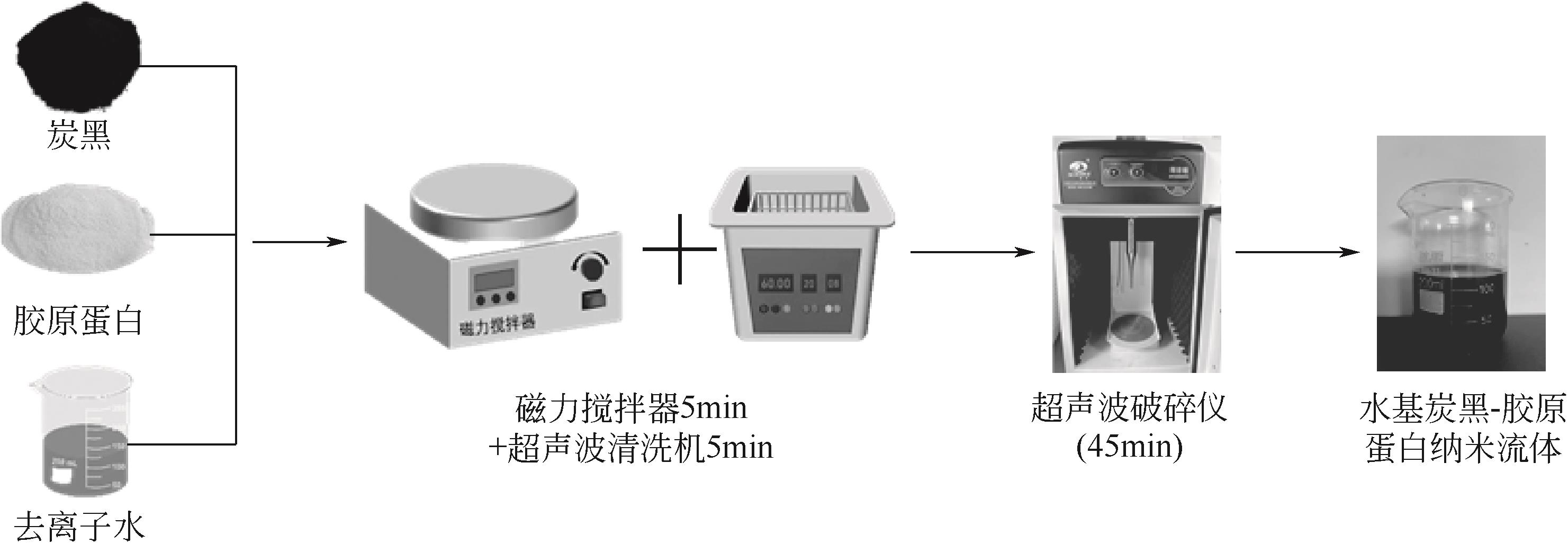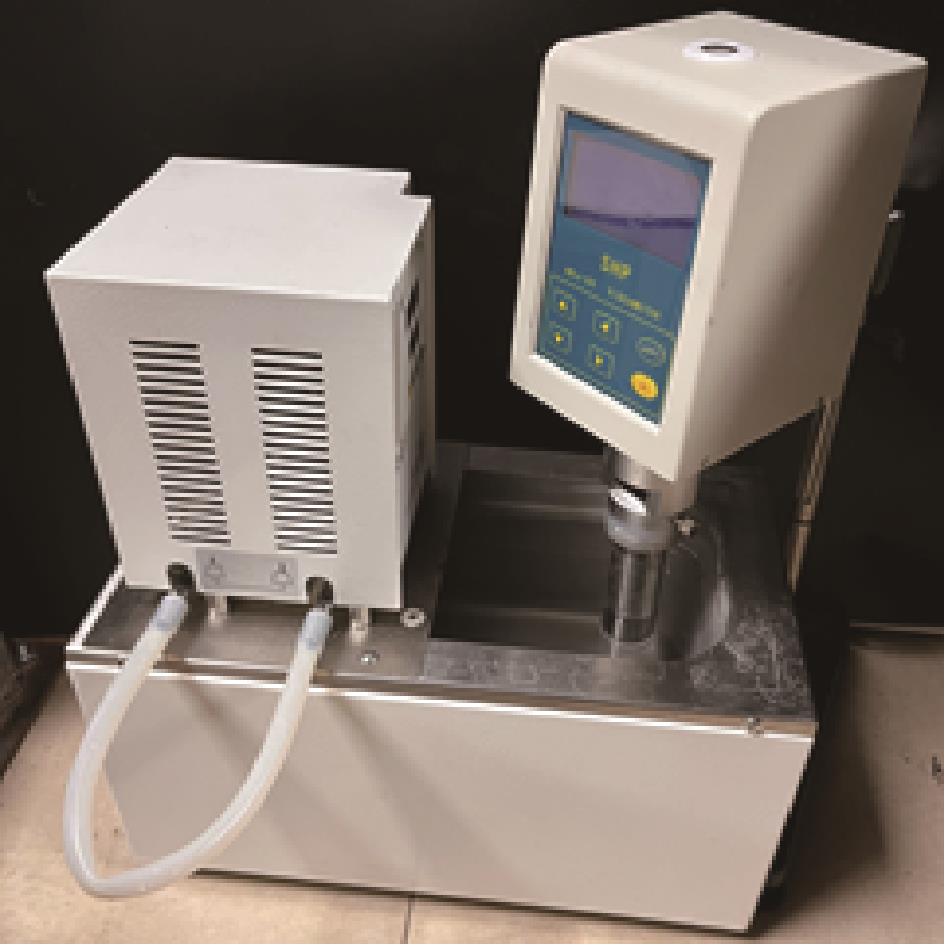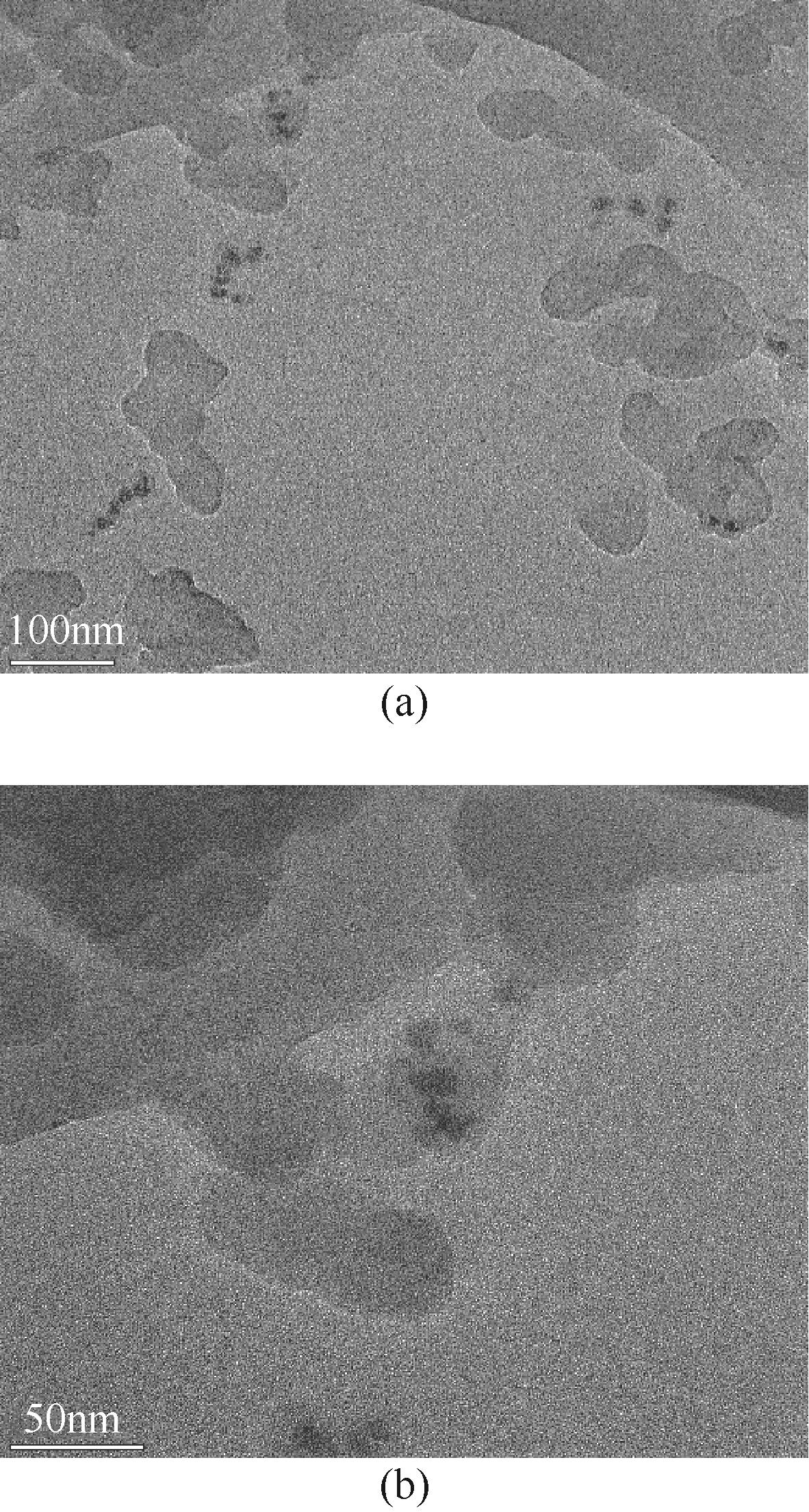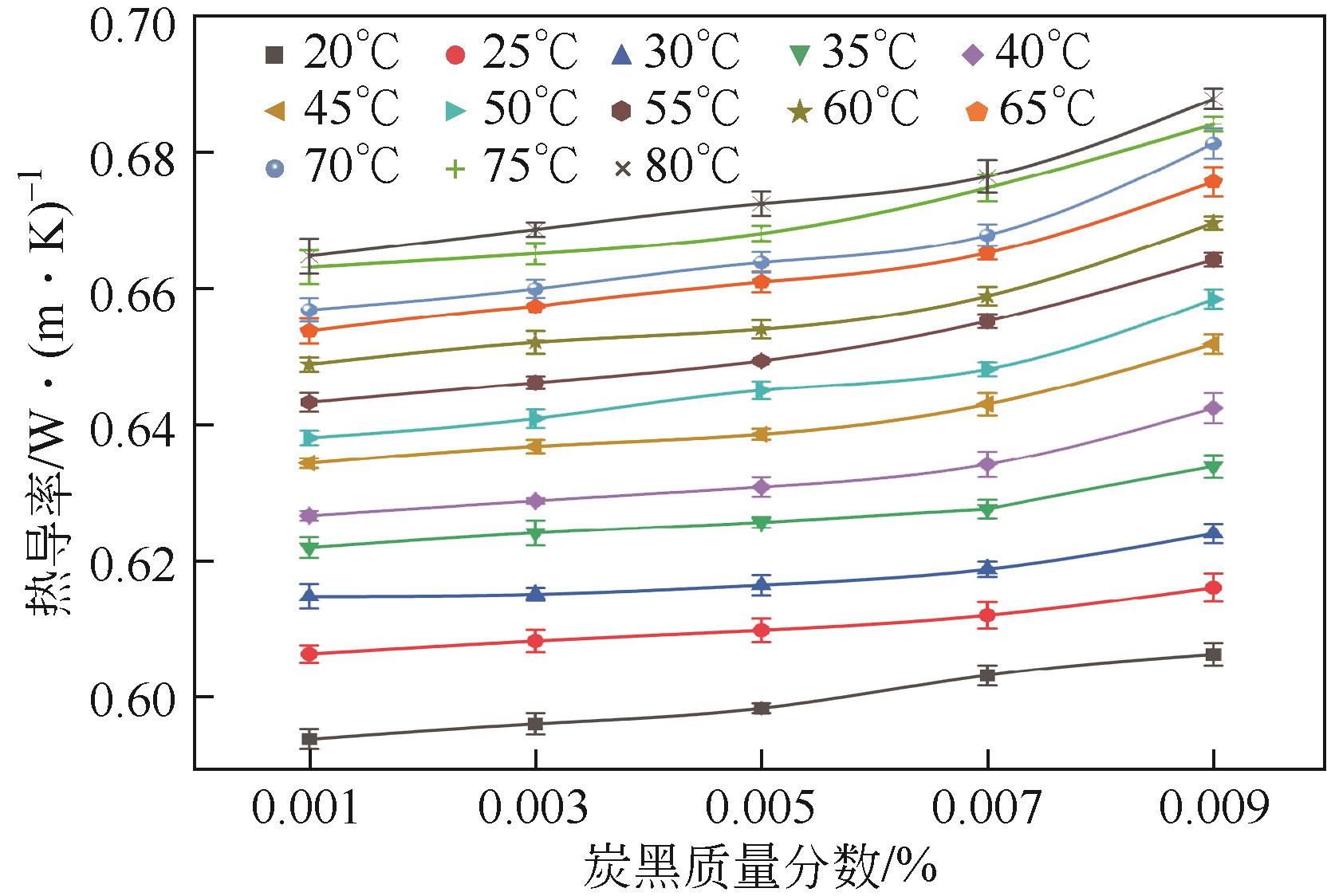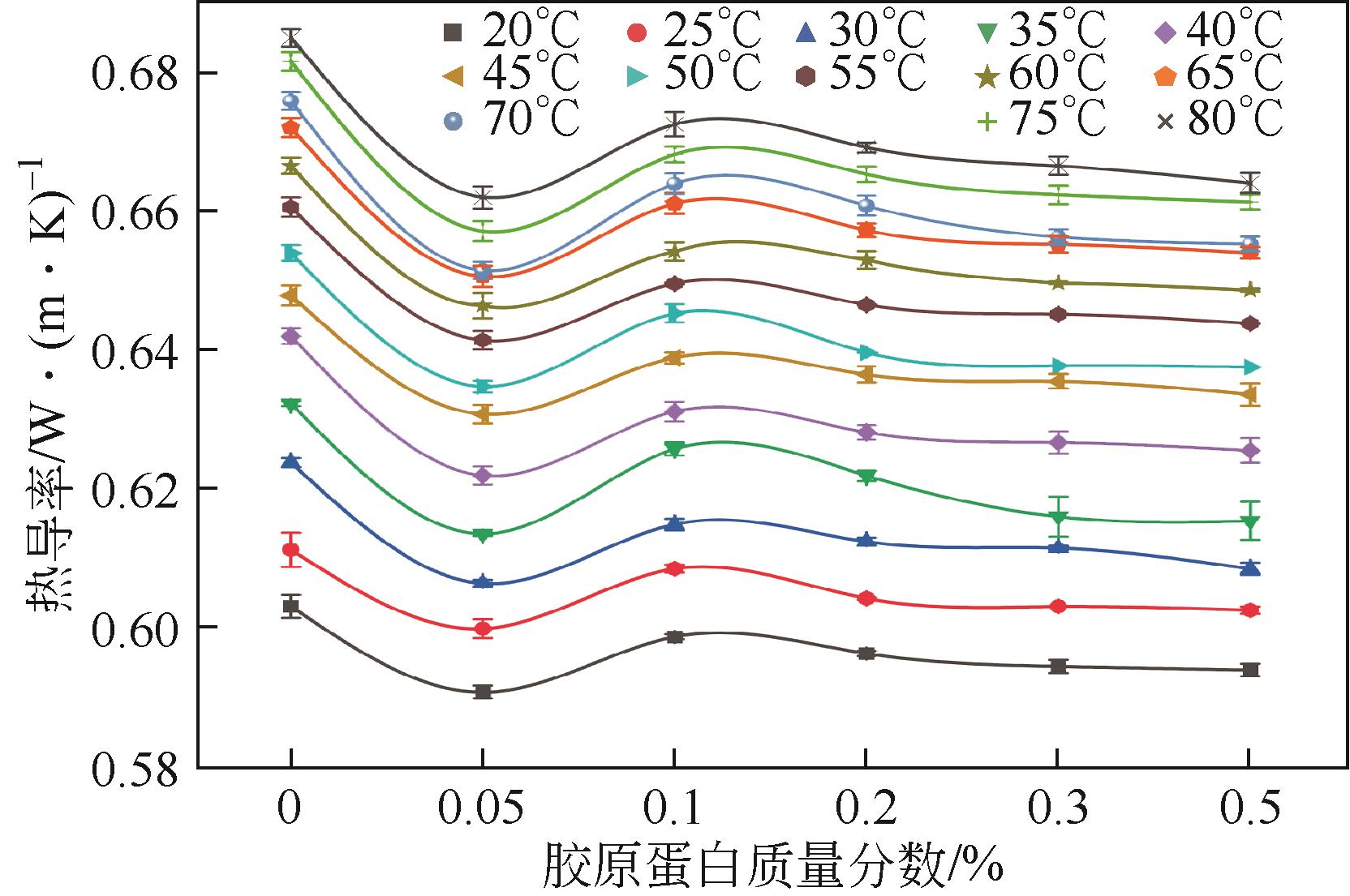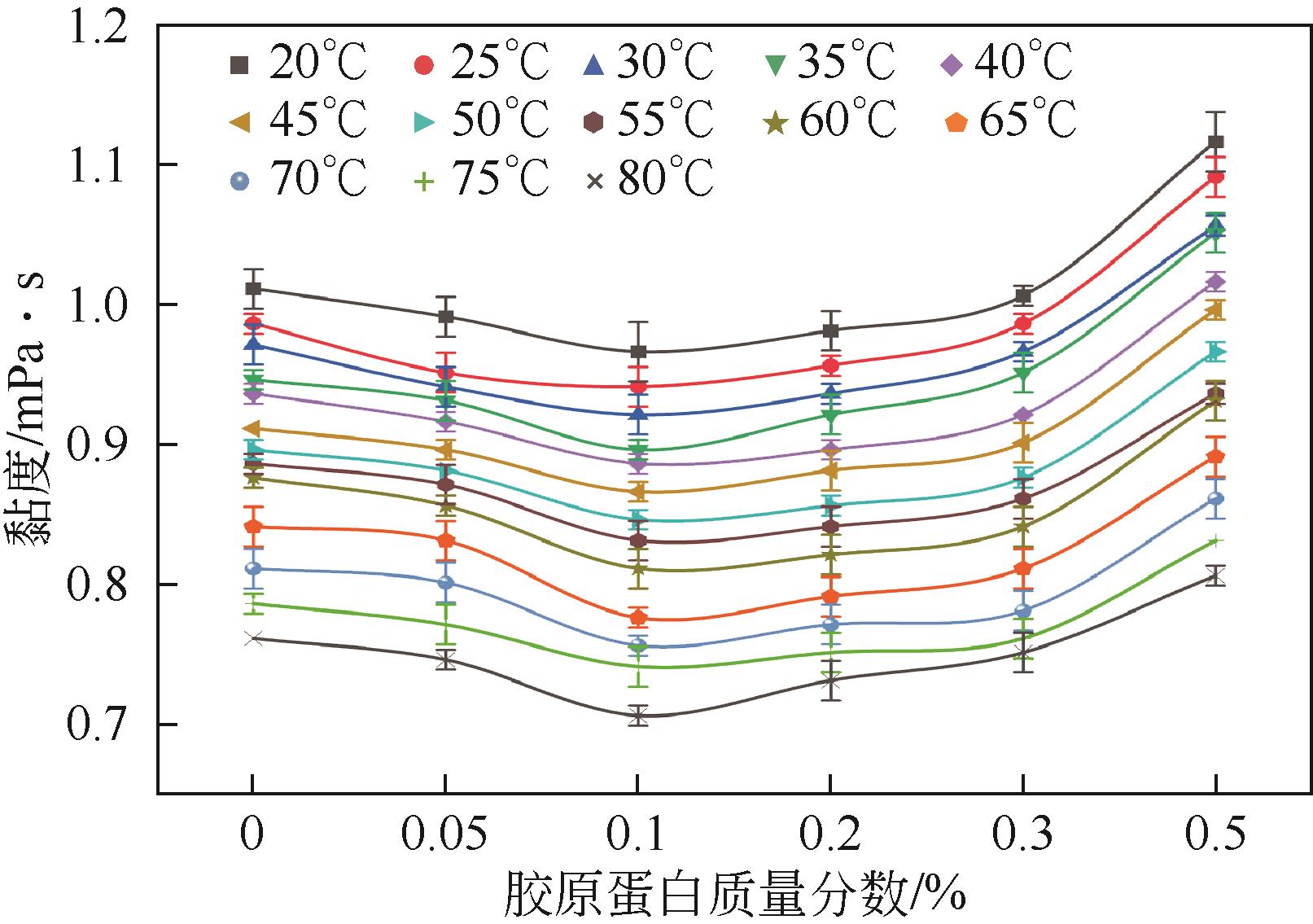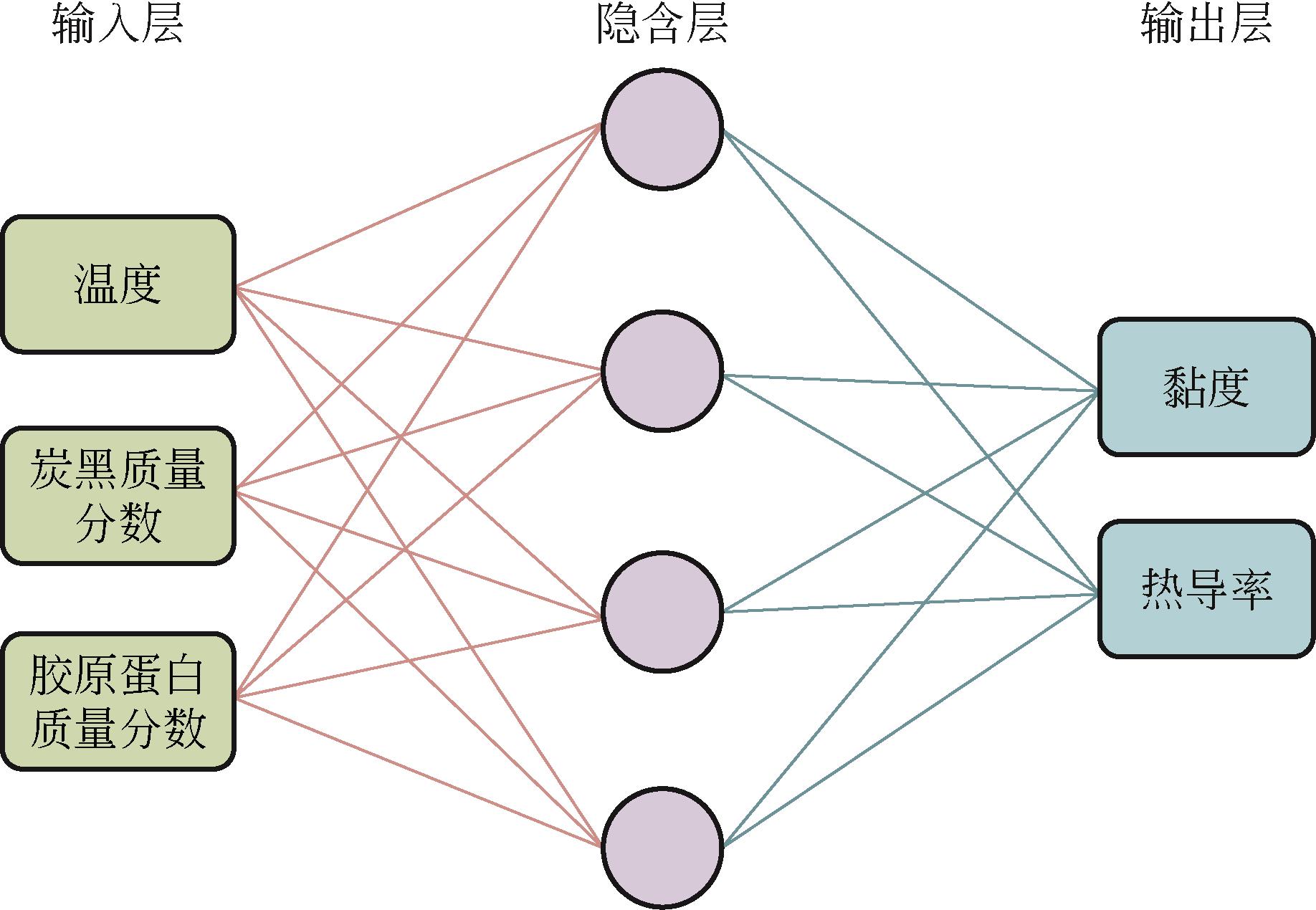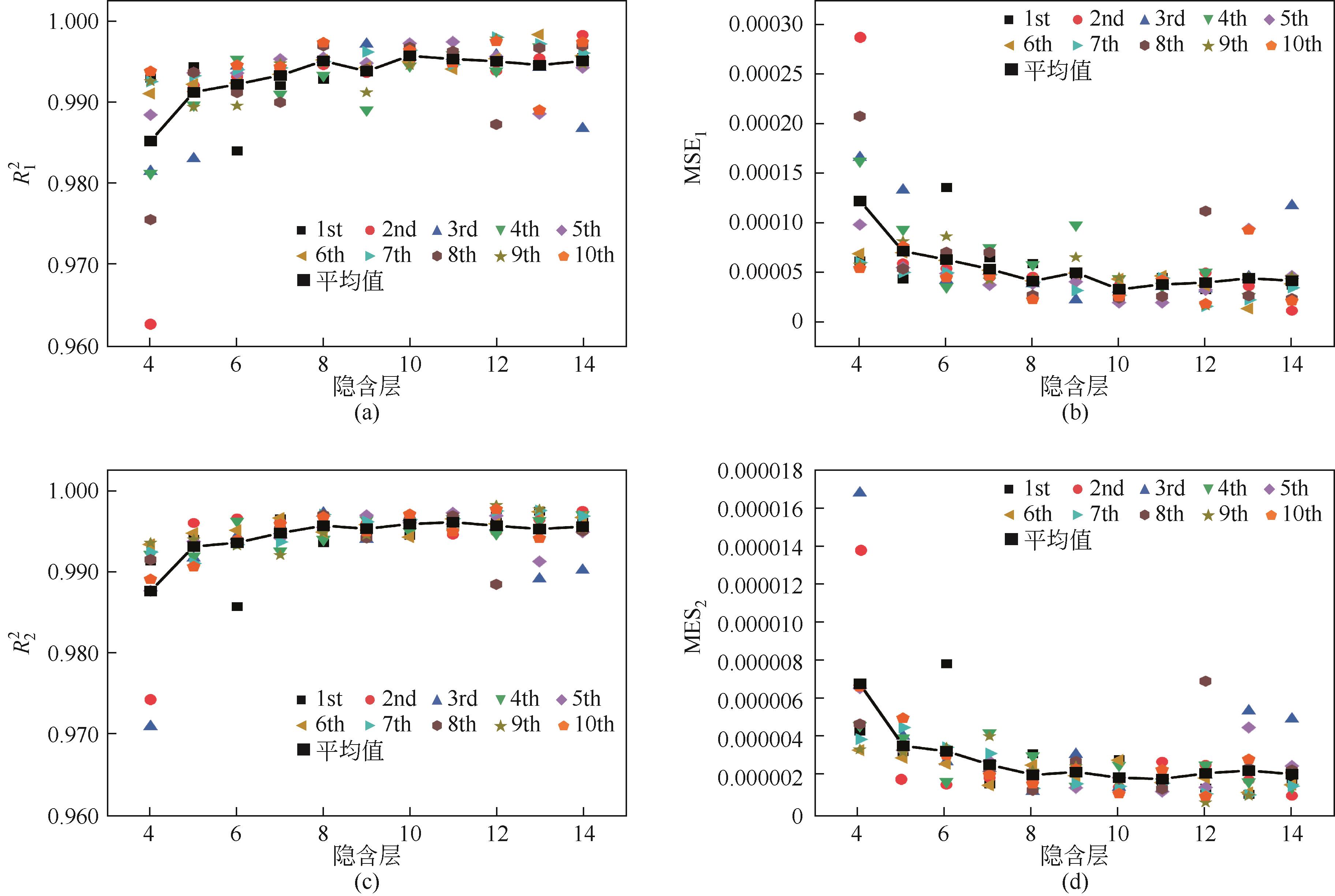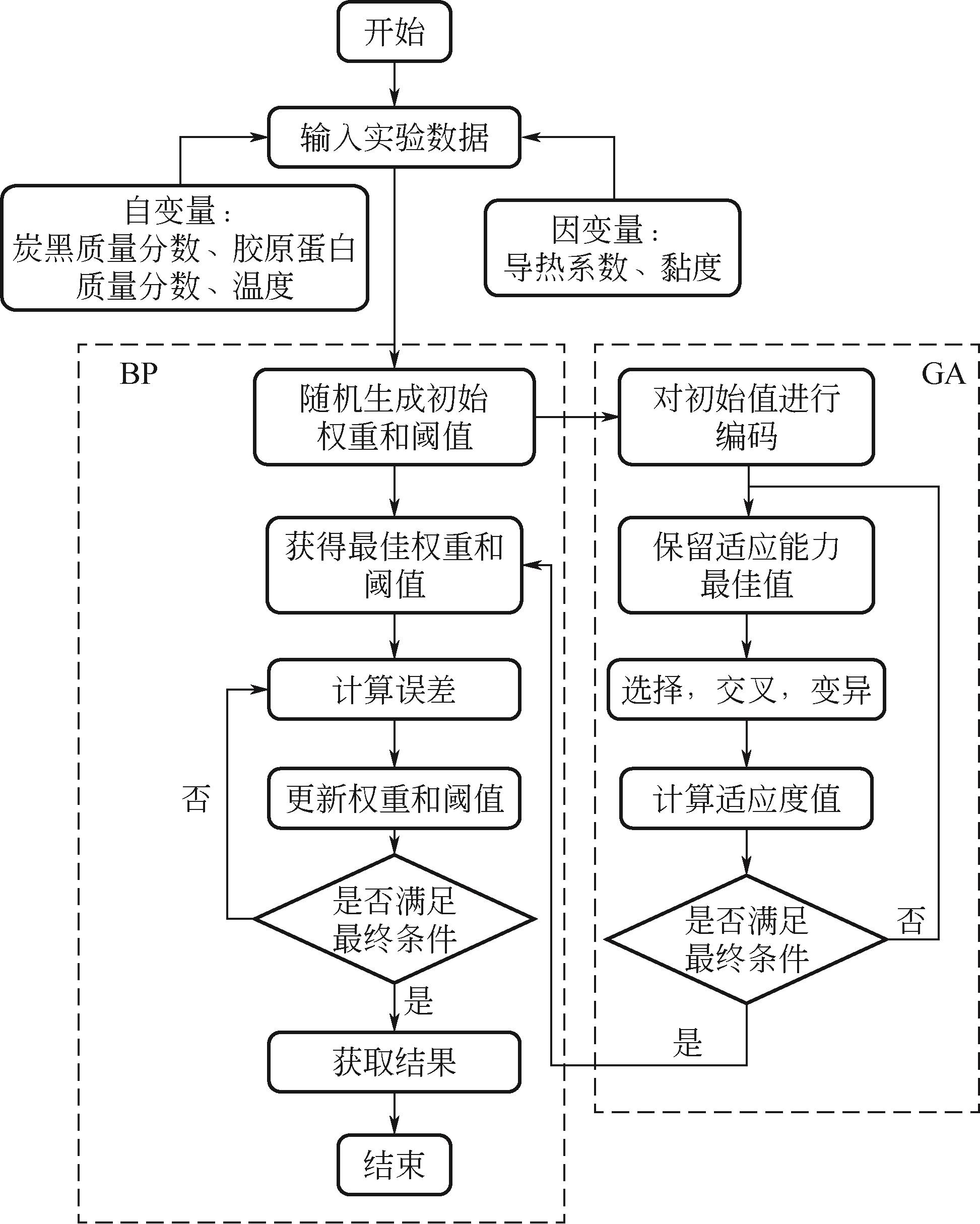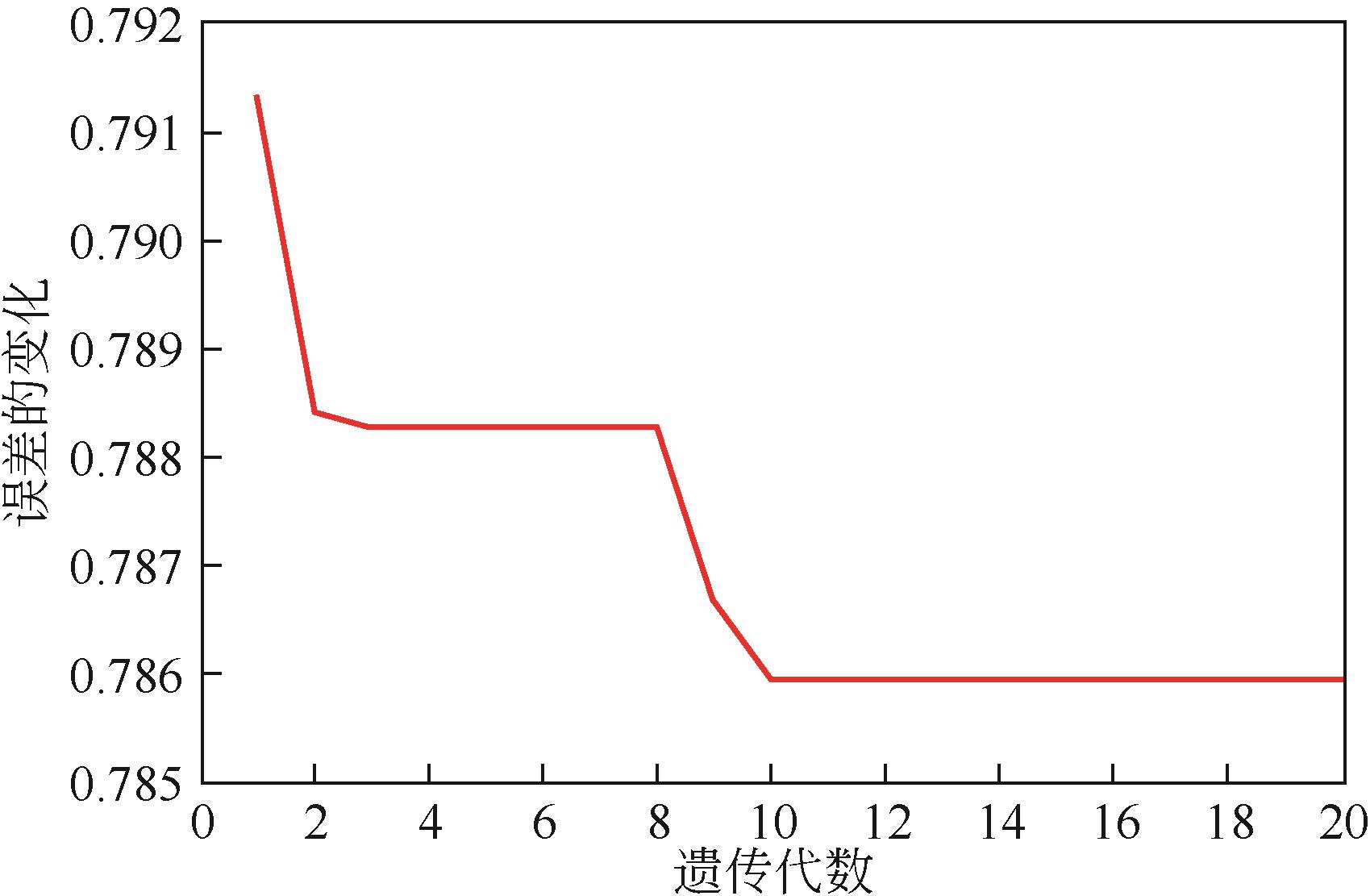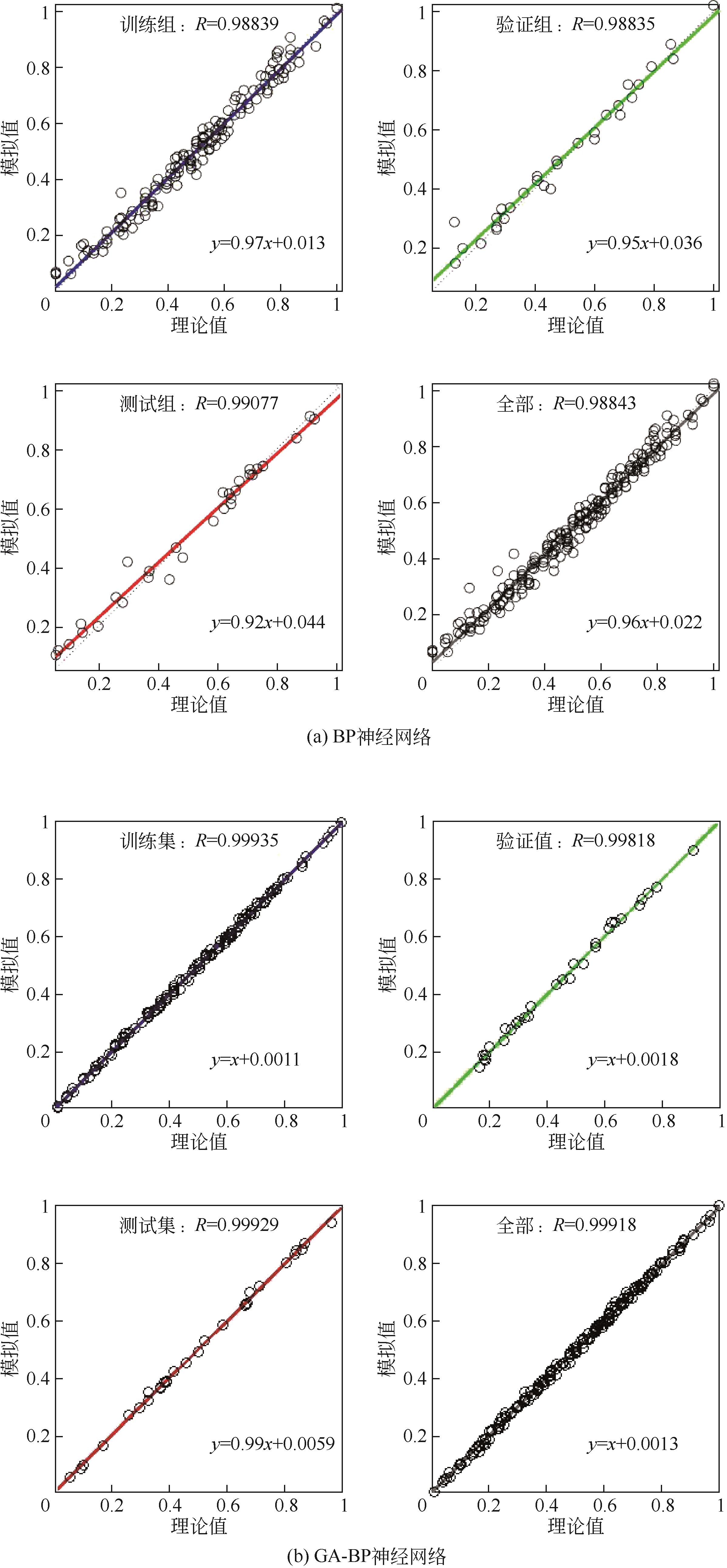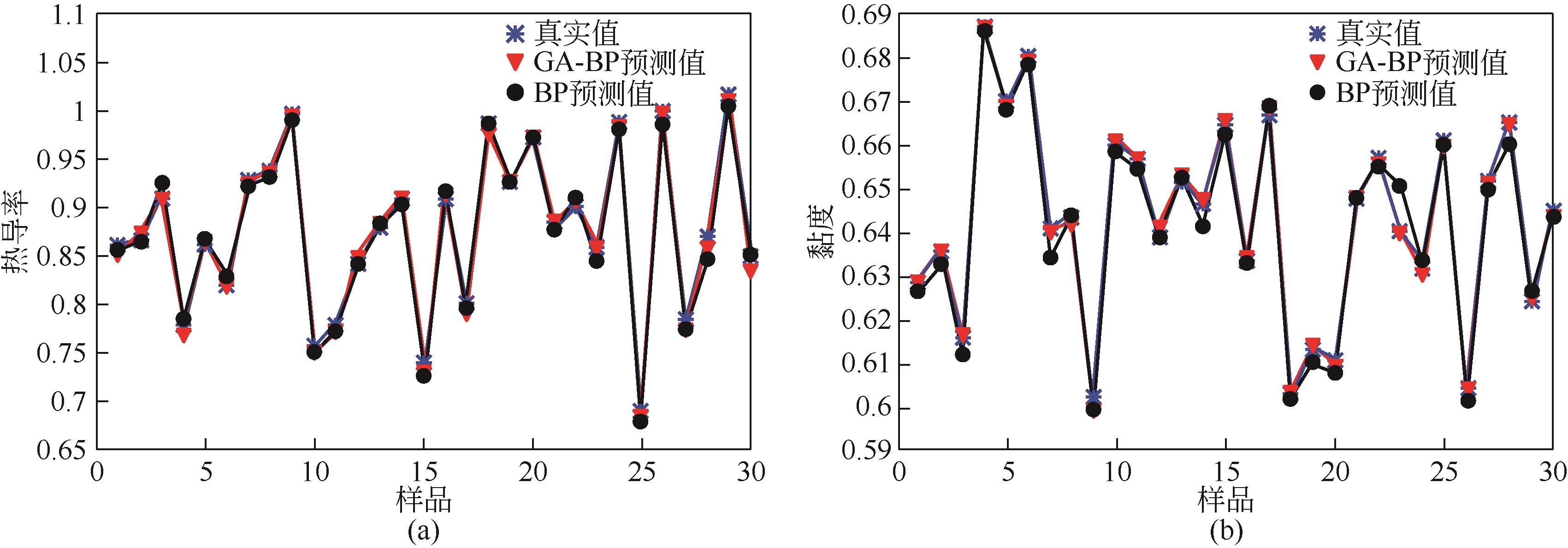化工进展 ›› 2024, Vol. 43 ›› Issue (7): 4138-4147.DOI: 10.16085/j.issn.1000-6613.2023-0961
• 资源与环境化工 • 上一篇
基于GA-BP神经网络模型预测水基炭黑-胶原蛋白纳米流体热导率和黏度
李凯( ), 魏鹤琳, 尹志凡, 左夏华, 于晓宇, 尹宏远, 杨卫民, 阎华, 安瑛(
), 魏鹤琳, 尹志凡, 左夏华, 于晓宇, 尹宏远, 杨卫民, 阎华, 安瑛( )
)
- 北京化工大学机电工程学院,北京 100029
-
收稿日期:2023-06-12修回日期:2023-08-06出版日期:2024-07-10发布日期:2024-08-14 -
通讯作者:安瑛 -
作者简介:李凯(1998—),男,硕士研究生,研究方向为纳米流体光热转换。Email:13834742296@163.com。 -
基金资助:国家自然科学基金(52176175)
Prediction of thermal conductivity and viscosity of water-based carbon black nanofluids based on GA-BP neural network model
LI Kai( ), WEI Helin, YIN Zhifan, ZUO Xiahua, YU Xiaoyu, YIN Hongyuan, YANG Weimin, YAN Hua, AN Ying(
), WEI Helin, YIN Zhifan, ZUO Xiahua, YU Xiaoyu, YIN Hongyuan, YANG Weimin, YAN Hua, AN Ying( )
)
- College of Mechanical and Electrical Engineering, Beijing University of Chemical Technology, Beijing 100029, China
-
Received:2023-06-12Revised:2023-08-06Online:2024-07-10Published:2024-08-14 -
Contact:AN Ying
摘要:
纳米流体由于其独特的强化传热性能,已广泛应用于各个领域。而热导率和黏度直接影响纳米流体在实际工程中的适用性,因此在考察纳米流体的强化传热特性前首先要分析研究其热导率和黏度。本研究利用炭黑和胶原蛋白,采用两步法制备了水基炭黑胶原蛋白纳米流体。实验分析了炭黑和胶原蛋白质量分数、温度对纳米流体热导率和黏度的影响。采用灰色关联方法对这些参数的权重进行了数学计算,基于实验数据建立了三输入两输出的BP神经网络预测模型,并利用遗传算法(GA)对BP模型进行优化。结果表明,遗传算法优化后的BP神经网络模型对预测输出具有更高的准确性和更好的稳定性,回归系数和最大偏差分别为0.99918和0.002。本研究不仅对于理解和控制水基炭黑-胶原蛋白纳米流体的热物理性能有重要意义,而且为工程设计和材料科学等方面的应用提供了新思路。
中图分类号:
引用本文
李凯, 魏鹤琳, 尹志凡, 左夏华, 于晓宇, 尹宏远, 杨卫民, 阎华, 安瑛. 基于GA-BP神经网络模型预测水基炭黑-胶原蛋白纳米流体热导率和黏度[J]. 化工进展, 2024, 43(7): 4138-4147.
LI Kai, WEI Helin, YIN Zhifan, ZUO Xiahua, YU Xiaoyu, YIN Hongyuan, YANG Weimin, YAN Hua, AN Ying. Prediction of thermal conductivity and viscosity of water-based carbon black nanofluids based on GA-BP neural network model[J]. Chemical Industry and Engineering Progress, 2024, 43(7): 4138-4147.
| 影响因素 | 热导率 | 黏度 |
|---|---|---|
| 炭黑质量分数 | 0.852 | 0.746 |
| 胶原蛋白质量分数 | 0.667 | 0.856 |
| 温度 | 0.808 | 0.538 |
表1 灰色关联度分析
| 影响因素 | 热导率 | 黏度 |
|---|---|---|
| 炭黑质量分数 | 0.852 | 0.746 |
| 胶原蛋白质量分数 | 0.667 | 0.856 |
| 温度 | 0.808 | 0.538 |
| 1 | BAHIRAEI Mehdi, RAHMANI Reza, YAGHOOBI Ali, et al. Recent research contributions concerning use of nanofluids in heat exchangers: A critical review[J]. Applied Thermal Engineering, 2018, 133: 137-159. |
| 2 | YAZDANIFARD Farideh, AMERI Mehran, Ehsan EBRAHIMNIA-BAJESTAN. Performance of nanofluid-based photovoltaic/thermal systems: A review[J]. Renewable and Sustainable Energy Reviews, 2017, 76: 323-352. |
| 3 | SAJID Muhammad Usman, Hafiz Muhammad ALI. Recent advances in application of nanofluids in heat transfer devices: A critical review[J]. Renewable and Sustainable Energy Reviews, 2019, 103: 556-592. |
| 4 | SAHIN Ahmet Z, UDDIN Mohammed Ayaz, YILBAS Bekir S, et al. Performance enhancement of solar energy systems using nanofluids: An updated review[J]. Renewable Energy, 2020, 145: 1126-1148. |
| 5 | CUCE Erdem, CUCE Pinar Mert, GUCLU Tamer, et al. On the use of nanofluids in solar energy applications[J]. Journal of Thermal Science, 2020, 29(3): 513-534. |
| 6 | MADHESH D, PARAMESHWARAN R, KALAISELVAM S. Experimental investigation on convective heat transfer and rheological characteristics of Cu-TiO2 hybrid nanofluids[J]. Experimental Thermal and Fluid Science, 2014, 52: 104-115. |
| 7 | YANG Liu, XU Jianyong, DU Kai, et al. Recent developments on viscosity and thermal conductivity of nanofluids[J]. Powder Technology, 2017, 317: 348-369. |
| 8 | CHIAM H W, AZMI W H, USRI N A, et al. Thermal conductivity and viscosity of Al2O3 nanofluids for different based ratio of water and ethylene glycol mixture[J]. Experimental Thermal and Fluid Science, 2017, 81: 420-429. |
| 9 | SYAM SUNDAR L, VENKATA RAMANA E, SINGH Manoj K, et al. Thermal conductivity and viscosity of stabilized ethylene glycol and water mixture Al2O3 nanofluids for heat transfer applications: An experimental study[J]. International Communications in Heat and Mass Transfer, 2014, 56: 86-95. |
| 10 | SYAM SUNDAR L, SINGH Manoj K, SOUSA Antonio C M. Investigation of thermal conductivity and viscosity of Fe3O4 nanofluid for heat transfer applications[J]. International Communications in Heat and Mass Transfer, 2013, 44: 7-14. |
| 11 | ALAWI Omer A, SIDIK Nor Azwadi Che, XIAN Hongwei, et al. Thermal conductivity and viscosity models of metallic oxides nanofluids[J]. International Journal of Heat and Mass Transfer, 2018, 116: 1314-1325. |
| 12 | LEE Gyoung-Ja, KIM Chang Kyu, LEE Min ku, et al. Thermal conductivity enhancement of ZnO nanofluid using a one-step physical method[J]. Thermochimica Acta, 2012, 542: 24-27. |
| 13 | ESFE Hemmat Mohammad, AFRAND Masoud, GHAREHKHANI Samira, et al. An experimental study on viscosity of alumina-engine oil: Effects of temperature and nanoparticles concentration[J]. International Communications in Heat and Mass Transfer, 2016, 76: 202-208. |
| 14 | BARATPOUR Mohsen, KARIMIPOUR Arash, AFRAND Masoud, et al. Effects of temperature and concentration on the viscosity of nanofluids made of single-wall carbon nanotubes in ethylene glycol[J]. International Communications in Heat and Mass Transfer, 2016, 74: 108-113. |
| 15 | WUSIMAN Kuerbanjiang, JEONG Hyomin, TULUGAN Kelimu, et al. Thermal performance of multi-walled carbon nanotubes (MWCNTs) in aqueous suspensions with surfactants SDBS and SDS[J]. International Communications in Heat and Mass Transfer, 2013, 41: 28-33. |
| 16 | KIM Nam-Jin, PARK Sung-Seek, Sang Hoon LIM, et al. A study on the characteristics of carbon nanofluids at the room temperature (25℃)[J]. International Communications in Heat and Mass Transfer, 2011, 38(3): 313-318. |
| 17 | XU J Z, GAO B Z, KANG F Y. A reconstruction of Maxwell model for effective thermal conductivity of composite materials[J]. Applied Thermal Engineering, 2016, 102: 972-979. |
| 18 | CHEN Haisheng, DING Yulong, HE Yurong, et al. Rheological behaviour of ethylene glycol based titania nanofluids[J]. Chemical Physics Letters, 2007, 444(4/5/6): 333-337. |
| 19 | AFRAND Masoud, TOGHRAIE Davood, SINA Nima. Experimental study on thermal conductivity of water-based Fe3O4 nanofluid: Development of a new correlation and modeled by artificial neural network[J]. International Communications in Heat and Mass Transfer, 2016, 75: 262-269. |
| 20 | KHDHER Abdolbaqi Mohammed, SIDIK Nor Azwadi Che, HAMZAH Wan Azmi Wan, et al. An experimental determination of thermal conductivity and electrical conductivity of bio glycol based Al2O3 nanofluids and development of new correlation[J]. International Communications in Heat and Mass Transfer, 2016, 73: 75-83. |
| 21 | VILLARRUBIA Gabriel, DE PAZ Juan F, CHAMOSO Pablo, et al. Artificial neural networks used in optimization problems[J]. Neurocomputing, 2018, 272: 10-16. |
| 22 | Seongmin HEO, LEE Jay H. Fault detection and classification using artificial neural networks[J]. IFAC-PapersOnLine, 2018, 51(18): 470-475. |
| 23 | CHRIS TSENG H, ALMOGAHED Bassam. Modular neural networks with applications to pattern profiling problems[J]. Neurocomputing, 2009, 72(10/11/12): 2093-2100. |
| 24 | David Daniel COX, DEAN Thomas. Neural networks and neuroscience-inspired computer vision[J]. Current Biology, 2014, 24(18): R921-R929. |
| 25 | ADUN Humphrey, Ifeoluwa WOLE-OSHO, OKONKWO Eric C, et al. A neural network-based predictive model for the thermal conductivity of hybrid nanofluids[J]. International Communications in Heat and Mass Transfer, 2020, 119: 104930. |
| 26 | QING Haohua, HAMEDI Sajad, EFTEKHARI S ALI, et al. A well-trained feed-forward perceptron Artificial Neural Network (ANN) for prediction the dynamic viscosity of Al2O3-MWCNT ( 40 ∶ 60 ) -Oil SAE50 hybrid nano-lubricant at different volume fraction of nanoparticles, temperatures, and shear rates[J]. International Communications in Heat and Mass Transfer, 2021, 128: 105624. |
| 27 | ESFE Hemmat Mohammad, MOTAHARI Kazem, SANATIZADEH Ehsan, et al. Estimation of thermal conductivity of CNTs-water in low temperature by artificial neural network and correlation[J]. International Communications in Heat and Mass Transfer, 2016, 76: 376-381. |
| 28 | ESFE Hemmat Mohammad, ROSTAMIAN Hadi, AFRAND Masoud, et al. Modeling and estimation of thermal conductivity of MgO-water/EG ( 60 ∶ 40 ) by artificial neural network and correlation[J]. International Communications in Heat and Mass Transfer, 2015, 68: 98-103. |
| 29 | ESFE Hemmat Mohammad, HASSANI AHANGAR Mohammad Reza, REJVANI Mousa, et al. Designing an artificial neural network to predict dynamic viscosity of aqueous nanofluid of TiO2 using experimental data[J]. International Communications in Heat and Mass Transfer, 2016, 75: 192-196. |
| 30 | ESFE Hemmat Mohammd, WONGWISES Somchai, NADERI Ali, et al. Thermal conductivity of Cu/TiO2-water/EG hybrid nanofluid: Experimental data and modeling using artificial neural network and correlation[J]. International Communications in Heat and Mass Transfer, 2015, 66: 100-104. |
| 31 | ESFE Hemmat Mohammad, SAEDODIN Seyfolah, NADERI Ali, et al. Modeling of thermal conductivity of ZnO-EG using experimental data and ANN methods[J]. International Communications in Heat and Mass Transfer, 2015, 63: 35-40. |
| 32 | ESFE Hemmat Mohammad, AFRAND Masoud, YAN Wei-Mon, et al. Applicability of artificial neural network and nonlinear regression to predict thermal conductivity modeling of Al2O3-water nanofluids using experimental data[J]. International Communications in Heat and Mass Transfer, 2015, 66: 246-249. |
| 33 | ESFE Hemmat Mohammad, BAHIRAEI Mehdi, HAJMOHAMMAD Mohammad Hadi, et al. Rheological characteristics of MgO/oil nanolubricants: Experimental study and neural network modeling[J]. International Communications in Heat and Mass Transfer, 2017, 86: 245-252. |
| 34 | ESFE Hemmat Mohammad, SAEDODIN Seyfolah, SINA Nima, et al. Designing an artificial neural network to predict thermal conductivity and dynamic viscosity of ferromagnetic nanofluid[J]. International Communications in Heat and Mass Transfer, 2015, 68: 50-57. |
| 35 | ZHANG Huiying, YAN Suying, GAO Hongjian, et al. Experimental investigation and prediction of changes in thermal conductivity of carbon nanotube nanofluid[J]. International Communications in Heat and Mass Transfer, 2021, 127: 105526. |
| 36 | 李凯, 魏鹤琳, 左夏华, 等. 水基炭黑-胶原蛋白纳米流体制备及稳定性实验[J]. 化工进展, 2024, 43(4): 1944-1952. |
| LI Kai, WEI Helin, ZUO Xiahua, et al. Experimental study on the preparation and stability of water-based carbon black-collagen nanofluids[J]. Chemical Industry and Engineering Progress, 2024, 43(4): 1944-1952. | |
| 37 | 李浩然. ZnO纳米流体传热特性实验研究[D]. 哈尔滨: 哈尔滨工业大学, 2015. |
| LI Haoran. Experimental investigation on heat transfer characteristics of ZnO nanofluids[D]. Harbin: Harbin Institute of Technology, 2015. | |
| 38 | LI Xiaoke, ZOU Changjun, CHEN Wenjing, et al. Experimental investigation of β-cyclodextrin modified carbon nanotubes nanofluids for solar energy systems: Stability, optical properties and thermal conductivity[J]. Solar Energy Materials and Solar Cells, 2016, 157: 572-579. |
| 39 | WEN Jin, LI Xiaoke, CHEN Wenjing, et al. Systematical investigation on the solar-thermal conversion performance of TiN plasmonic nanofluids for the direct absorption solar collectors[J]. Colloids and Surfaces A: Physicochemical and Engineering Aspects, 2021, 624: 126837. |
| 40 | 杨丰源. SX区块优势通道识别与分布特征研究[D]. 大庆: 东北石油大学, 2017. |
| YANG Fengyuan. Research on the identifying and distribution characteristics the thief zones in SX area[D]. Daqing: Northeast Petroleum University, 2017. | |
| 41 | 刘璐, 杨丹, 陈睿杰, 等. 基于KPCA-GA-BP神经网络的POI质量预测研究[J]. 电信科学, 2023, 39(1): 108-116. |
| LIU Lu, YANG Dan, CHEN Ruijie, et al. Research on POI quality prediction based on KPCA-GA-BP neural network[J]. Telecommunications Science, 2023, 39(1): 108-116. |
| [1] | 王定友, 陈建, 范汝新, 李大舜. 热裂解烃制炭黑的机理及工程化技术发展历程[J]. 化工进展, 2024, 43(7): 3551-3566. |
| [2] | 武西宁, 张宁, 秦佳敏, 徐龙, 魏朝阳, 马晓迅. 低冷量下强化CO2吸收的甲醇基纳米流体性能[J]. 化工进展, 2024, 43(5): 2811-2822. |
| [3] | 李凯, 魏鹤琳, 左夏华, 杨卫民, 阎华, 安瑛. 水基炭黑-胶原蛋白纳米流体制备及稳定性实验[J]. 化工进展, 2024, 43(4): 1944-1952. |
| [4] | 王凯, 罗明良, 李明忠, 黄飞飞, 蒲春生, 蒲景阳, 樊乔. 水驱油藏聚乙烯亚胺交联聚合物凝胶体系研究进展[J]. 化工进展, 2024, 43(3): 1506-1523. |
| [5] | 刘泽鹏, 曾纪珺, 唐晓博, 赵波, 韩升, 廖袁淏, 张伟. 四种烷基咪唑磷酸酯离子液体的热力学性质[J]. 化工进展, 2024, 43(3): 1484-1491. |
| [6] | 刘泽鹏, 曾纪珺, 廖袁淏, 唐晓博, 赵波, 韩升, 张伟. 离子液体1-乙基-3-甲基咪唑亚磷酸甲酯盐与1-乙基-3-甲基咪唑亚磷酸乙酯盐的热物性[J]. 化工进展, 2024, 43(2): 1054-1062. |
| [7] | 王敬翰, 吕杰, 赵丁, 林文野, 宋文吉, 冯自平. 基于BP神经网络的电动汽车动力电池产热估计[J]. 化工进展, 2024, 43(1): 400-406. |
| [8] | 张岱凌, 丁玉梅, 左夏华, 黎昊为, 杨卫民, 阎华, 安瑛. 废弃墨粉纳米流体的光热特性[J]. 化工进展, 2023, 42(9): 4791-4798. |
| [9] | 谢志伟, 吴张永, 朱启晨, 蒋佳骏, 梁天祥, 刘振阳. 植物油基Ni0.5Zn0.5Fe2O4磁流体的黏度特性及磁黏特性[J]. 化工进展, 2023, 42(7): 3623-3633. |
| [10] | 陈蔚阳, 宋欣, 殷亚然, 张先明, 朱春英, 付涛涛, 马友光. 矩形微通道内液相黏度对气泡界面的作用机制[J]. 化工进展, 2023, 42(7): 3468-3477. |
| [11] | 娄宝辉, 吴贤豪, 张驰, 陈臻, 冯向东. 纳米流体用于二氧化碳吸收分离研究进展[J]. 化工进展, 2023, 42(7): 3802-3815. |
| [12] | 孙征楠, 李洪晶, 荆国林, 张福宁, 颜飚, 刘晓燕. EVA及其改性聚合物在原油降凝剂领域的应用[J]. 化工进展, 2023, 42(6): 2987-2998. |
| [13] | 郭文杰, 翟玉玲, 陈文哲, 申鑫, 邢明. Al2O3-CuO/水混合纳米流体对流传热性能及热经济性分析[J]. 化工进展, 2023, 42(5): 2315-2324. |
| [14] | 李光文, 华渠成, 黄作鑫, 达志坚. 聚甲基丙烯酸酯类黏度指数改进剂的研究进展[J]. 化工进展, 2023, 42(3): 1562-1571. |
| [15] | 蒋佳骏, 吴张永, 朱启晨, 蔡昌礼, 朱家军, 王志强. In-Bi-Sn基Si3N4/GNFs混合纳米流体的流变性和润滑性[J]. 化工进展, 2023, 42(12): 6197-6206. |
| 阅读次数 | ||||||
|
全文 |
|
|||||
|
摘要 |
|
|||||
